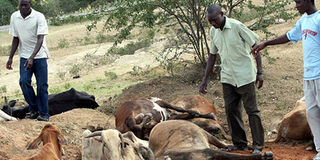Breaking News: At least 10 feared to have drowned in Makueni river
Food: Kenya's next crisis after water and electricity

Men walk past dead cattle in Narok on Sunday. More than 80,000 animals have been driven from Narok to Kwale District in search of water and grazing, with the drought showing no sign of letting up. Photo/LABAN WALLOGA
Kenya's Cabinet will meet in emergency session on Tuesday to agree on steps to prevent mass starvation across the country. The session will discuss the report of a sub-committee which paints an alarming picture of the food situation.
The report was given to the President two weeks ago and partly discussed at Cabinet last Friday. The government believes more than 10 million need food aid and the committee has made proposals on what needs to be done. Compiled by a cross-section of ministries, it details the shortage of food and water for people and livestock.
Only parts of Nyanza and Western provinces together with a section of Nakuru and some parts of Meru and Embu are generally food secure, the Kenya Red Cross said in a report at the weekend.
The drought is so severe that it has compromised food security in areas such as Rift Valley Province and Central Kenya, which are normally highly productive.
During the long rains season – March to May – the country received very little rain with some areas of northern Kenya and the greater Kajiado receiving none at all.
On top of dry taps and daylong blackouts, Prime Minister Raila Odinga has warned Parliament that this year, the maize harvest will be 20 million bags, 13 million bags short of the annual requirement.
He said the full severity of the food crisis was to be felt starting from the last week. The Kenyan economy is highly susceptible to drought. It pushes up the price of food and general inflation and forces the government to direct more of its resources to importing food at the expense of development.
President Kibaki, who chairs the Cabinet, left for an official visit to Zambia on Sunday but is expected back on Monday, in time for the meeting. Vice President Kalonzo Musyoka said urgent steps are needed to deal with the crisis.
“President Kibaki has convened a meeting of Cabinet committees this Tuesday to work on ways of solving the perennial problem of famine among other issues in the country,” said the VP.
He was speaking at Mivukoni Secondary School in Mwingi District on Saturday during a funds drive in aid of the institution. Malnutrition is particularly serious problem, according to the Red Cross, and in some parts of the country, one in every five children is not getting enough to eat.
Livestock continue to die at a very high rate, said the Red Cross. So far, 40 people have died from drought-related causes. “Most of these people are pastoralists who have died while fighting over scarcity of pasture and water,” KRC public relations and communication manager, Titus Mung’ou said on Sunday.
The latest Red Cross report said the areas worst affected by malnutrition include the larger Marsabit, Turkana, Mandera and Samburu. Other places where malnutrition levels are going up include Baringo as well as Kajiado and Kinango in the Coast Province where malnutrition has traditionally been rare. “This indicates a critical situation,” the report says.
According to the report, an assessment by Arid Lands Resources Management Project and other agencies last month in pastoralist and marginal agricultural parts of southeastern and coastal lowlands raises a red flag.
It says the current food security in these areas is precarious. The areas have been grouped into clusters. The first one is the Northern pastoral cluster. It comprises of Turkana, Moyale, the larger Marsabit and Samburu district.
Then there is Mandera, Wajir, Garissa, Isiolo and Tana River districts in the Eastern pastoral cluster. Agro-pastoral cluster, which includes Baringo, West Pokot, Laikipia and Kajiado is the third one while the fourth is the Eastern marginal agriculture areas of Tharaka, Mbeere, Makueni, Mwingi and Kitui districts.
The last one is the Coastal marginal agricultural region comprising of the districts of Taita, Taveta, Malindi, Kilifi and Kwale.
Water shortage
Information from Government departments, the UN agencies and NGOs, the Red Cross report said, also indicates that the worsening drought has led to severe water shortage.
And it warns: “This is likely to compromise safe water and sanitation services that could trigger waterborne diseases.”
Energy minister Kiraitu Murungi, after days of denial by the Kenya Power and Lighting Company (KPLC), last week announced power rationing because there isn’t enough water in the country to generate it.
Water minister Charity Ngilu has announced that her ministry is sinking boreholes in urban areas to meet water needs.
President Kibaki had in January this year declared the food crisis a national disaster and various measures were taken to ease the shortages, including the duty free importation of maize. But poor rains have worsened the situation.




